
Gentle Joseki, part IX
by Pieter Mioch
An introduction to corner patterns, especially but not only
meant for kyu players.
Introduction
By now everybody is aware that people in Japan do not
longer wear Kimono's for everyday life and that the
times of men in skirts with hair tied up in a bun and
with long pieces of menacing looking steel at their
sides is in the far past. Nostalgic emotions and a
hunger for the "good old times", however, have kept the
population interested in traditional stuff like the tea
ceremony, sumo and yes, go for the last half of the 20th
century.
Now that the Japanese economy is only moving at a snails
pace, if it is moving at all, corporate sponsors, on
which many of these traditional sports depend, are
tightening their belts and starting to pinch pennies.
As the larger part of the public does not seem to care
about tradition so much anymore less and less money
is available for "antique" events and combined with
internal trouble this puts the Japanese go association
(the nihon ki-in) in an extremely difficult situation.
The newspapers are not as generous with funds as they
once were although they still do guarantee enormous sums
of cash for prize money in the pro tournaments
As a first step to not "go under" the wages of
professional salaries have been cut up to 15% depending
on the tournament. As far I know since the Second World
War this has not happened. At the same time that the pay
for participating in the tournaments is going down the
going rate for go classes is getting cheaper, too. As
yet most pros are grumbling but not really complaining
and there does not seem to be anybody considering giving
up go and trying another profession. It feels possible,
however, to predict that in the next 10 years at least
some pros will have to reconsider their jobs and might
have to start something on the side.
To make things even worse, despite the unexpected
successes of the go comic "Hikaru no Go" in Japan the
number of people who play go say once a week seems to be
decreasing. The game of go is such an integral part of
the Japanese society that you do not need to worry about
go vanishing altogether or something. All the same, many
young people (under 40) feel that Go is something you
pick up after retirement as a preventive measure against
Alzheimer's disease. But then again, there are also
plenty of people who start playing mah-jongg for the same
reason.
To be honest, the number of participants in youth
tournaments held throughout the country has been
increasing the last couple of years. To think this means
that lots of young people at school are playing go now
is a mistake. Recently throngs of youngsters do realize
for the first time that there is a game called go and
that it even might be cool. Unfortunately for 99% of
the parents behind possible go protégé's
goes that education is the top priority in life. Video
games are allowed as a necessary evil, to help children
to relax and let off steam but only few parents will
encourage their brats to put time in go. This is an
extremely unfortunate situation as everything necessary
to raise a new generation of world-top pros is still there.
The know-how, the equipment and high level of pros
and amateurs ready to take talent under their wings,
however this all mean nothing without the support of the
parents. If the Japanese society does not make a 180 degree
turn fast and start paying attention to matters besides good
grades and video games the level of go in the next 50
years will not be up to meet the world.
What does all this have to do with me? Well, everything,
actually. My senior citizen's class I get paid for
is going steady, everybody's happy and the number of
participants does not change much. At other days, when
I'm not teaching, the number of people attending has
been going down and as a result my boss, Tsuchida 9p,
is desperately looking for new students. So, at every
go event in Gifu prefecture you can find me now, that
6'6" pink elephant standing there on the stage in front
of a group of Japanese spectators telling them why they
really *must* come over, join and start playing go at
Tsuchida's club.
To end this depressing story with some good news, my
elementary school go classes are doing fine and I even
got a couple of mothers playing now, just to make sure
that go doesn't stop the moment school's out and that
interested children have enough chance to play at home
too.
P.S. It goes without saying that I'm trying to turn
the situation in Japan around and "father" the next
generation go fanatics. As Yuki Shigeno confessed when
I spoke her a couple of years ago: "What I'm trying
to do is to help spreading the game of go all through
Europe and make it so popular that people in Japan will
become interested in playing again. Japanese people
love everything foreign so I guess that what I'm saying
is that I'm trying to save go in Japan by importing it back..."
The Patterns
As usual I've underestimated the amount of even the most
basic diagrams concerning the 4-3 point. There is no way
on earth I can tell all the things you should know in
order to be able to start feeling confident in your own
games when playing 4-3.
The ko-moku move is low, as I said before and if there's
one thing you should try to pick-up from Gentle Joseki 8
and 9 it is that the 4-3 move lacks in attacking strength
because of it.
Well, that was one something which deserves a single
episode by itself but, alas, not this time. I'll
continue with where I let off in Gentle Joseki XIII and
when I have some 20 diagrams I'll call it a day.
White Attaches |
 |
After a white approach move to the ko-moku stone playing
a pincer is the most likely way to lead to unpredictable
and difficult situations. In dia 1 blacked played the
two space high pincer. White has plenty of choice in how
to answer this pincer. The white answer I'd like you to
memorize by heart though is the attachment (tsuke) of
white 2. This is *the* move white has to keep things
simple and settle himself without messing up too much.
After black 7 white can play at either A or B to settle
his stones. Because of having two options white can play
elsewhere without having to worry.
|
Diagram 1 |
|
|
|
Playable But Not So Many Eyes |
 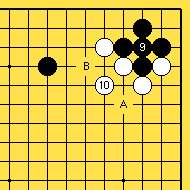
|
|
The dias 2 and 2a show that black can counter at 5
instead of letting white get easy eye shape. After
white 8 it is 98% out of the question to even consider
fighting this ko when playing black. Black 9 in dia 2a
is natural and white 10 might look cool, but?..White
should not be too happy with his shape. As black's
corner is alive black could very well choose to peep at
A and B and continue attacking the white stones. White
should be able to handle himself, of course, but for the
time being his stones have no eyes and feel a kind of
heavy.
|
Diagram 2 & 2a |
|
|
|
a Genuine Joseki |
 |
This is, as an exception to the normal Gentle Joseki
approach, a genuine joseki. Black 1 in dia 3 shows the
"go steady" attitude. After white 2 black can hook up
his stones with 3. Black is satisfied (even though he's
a bit low)
|
Diagram 3 |
|
|
|
Always Works |
 |
Dia 4, in short with *all* the pincers A-F the
attachment play of white 1 is possible. It most of the
time works similar to the dias I just showed you about
the two space high pincer. If black pincers at A white 1
might not be the best move, but it's still playable.
|
Diagram 4 |
|
|
|
White Settles His Stones |
 |
And I do it again! It is a real joseki! Be that as it
may, however, I think that this result is more than
white can hope for. White settled his stones most
effectively in spite of the fact that black played
the sever pincer of black 1. White 8, by the way, is
extremely big because white cannot extend towards the
left and instead of 8 playing elsewhere (tenuki) is
often a bad idea as black can take 8 and set the white
stones a floating.
|
Diagram 5 |
|
|
|
Not So Popular |
 |
There seems to be an unwritten law or at least a silent
agreement to not play the two-space low pincer of black
1 in dia 7 these days anymore. In my insei days my
"sensei" (teacher) was very font of this pincer because
most of his students did not study it as thoroughly
as the other, more popular pincers. I think it is an
excellent play and whatever the current fashion may be
by all means add this move to your standard-answers
repertoire. Playing white the opposite idea to the
attachment we just went over would be moving out and
jumping towards the center. A, B and C are just a few
possibilities which are playable with all the pincers
although they're maybe not always advisable if black
played any one-space pincer.
|
Diagram 7 |
|
|
|
I don't know about the correct line of playing too
much but judging from my own games jumping out leads
to "unsettling" at least a quarter of the board. I
mean that often both players end up with a number of
stone-strings of unclear status and feel they're in a
guerilla war.
Our Ships Are Sailing the Same Direction |
 |
One of the major options white often has when jumping
out as in dia 8 is to counter-pincer. This especially is
a very healthy attitude if white has the left corner. If
the triangle marked stone would be black's, however, the
counter-pincer could be too much for white to handle.
This is, again, a joseki. All the same you cannot expect
your opponent to follow suit. There are plenty of ways
to make a left turn somewhere and, as a matter of fact,
this is often called for.
|
Diagram 8 |
|
|
|
Be never satisfied just because you memorized
a joseki and got it on the board correctly. Being
suspicious of the outcome is the more recommendable
attitude, me thinks.
A Question |
 |
Black: Cheng Zengyu
White: Wang Yuan (+resign)
Played April 1986
Dia 9. I'm glad I could find some game from after WW2
were the two-space low pincer is played. From my search
results I can say without a doubt that this move is
nowhere as popular today as it was 60 years ago.
Next black to play, where would you play in your own
game A, B or C? Part of the continuation of the game is
given right at the end.
By the way, this is again a game where black had to
resign after having played an opening making two corner
enclosures (shimari). This makes six games in a row
including the games I checked out for Gentle Joseki 8.
I think it is time for me to start writing a thesis,
proving that black cannot win a game of go when having
two shimari. I still have no clue, however, why on earth
two shimari would be bad but it's intriguing to find
that black often loses. Still, it could very well be
coincidence, of course. I'll get back to you when I
checked on say 2000 games.
|
Diagram 9 |
|
|
|
No Big Deal |
 |
In dia 10 the remaining moves I have to go over are
given. You can make a big deal of the white approach
moves at B and C but I think they're not.
|
Diagram 10 |
|
|
|
Good For Black |
 |
If white wants something on the left side he often
chooses to play a little far from the corner, trying to
avoid being pincered. Well, let white do his worst and
give him a second move at the left side, I say. Black 2
makes excellent shape and after white 3 black can play
tenuki or make an extension in the neighborhood of A.
Black gets the better part out of this exchange.
|
Diagram 11 |
|
|
|
Good For Black Too |
 |
The same goes for dia 12. Just stay cool and play solid
moves and white only can make a thin extension towards
the left, no sweat. At a fairly early stage of the game
black might very well want to invade at A after which
white cannot hope to capture the invasion.
|
Diagram 12 |
|
|
|
'Lot of Moves |
 |
Dia 13 shows that there are certainly enough moves to
choose from if white played the one-space high approach
move. I have no personal favorite move but black E gives
black a lot of points while black still is the one who
can play elsewhere (tenuki) first.
|
Diagram 13 |
|
|
|
Good Enough for Black |
 |
Black is solid and got points in dia 14, he has no
reason to be dissatisfied. Black also can aim at the
troublesome move at A later on in the game. He should
not play here too fast but only just about when white is
starting to think that the upper left is his territory.
|
Diagram 14 |
|
|
|
Three Ko-Moku Joseki |
 |
Black: Kato Masao
White: Otake Hideo (+resign)
Played July 1978, 2nd round Gosei title
Dia 15. I don't have much room left that's why I decided
to show you this game between Otake "the master of
good style" Hideo and Kato "the Killer" Masao and show
you various aspects of the 4-3 move all in one diagram.
Try, among other things, to pick up something from the
lower left corner. Playing tenuki (or a pincer) *after*
your opponent has attached at the 3-3 point is quite a
common strategy. Now tell me, did you ever try that in
one of your own games?
White 18, by the way, is over extended. Black could play
between white 16-18 and probably eat the 2-16 stones.
White, however, does not care so much about that since
he regards the 2-16 as light.
|
Diagram 15 |
|
|
|
Alternative Joseki |
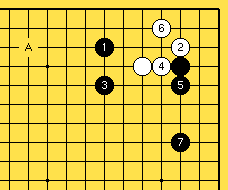 |
Dia 16 shows an alternative joseki, that is to say that
this might be playable but by no means common. Instead
of black 7 playing at A could very well be an excellent
choice.
|
Diagram 16 |
|
|
|
I just found another game to throw at you which I think
is worthwhile. It is between a local hero, Hikosaka
Naoto playing white and O Rissei who is currently one of
the strongest players in Japan, if not in the world.
There Ain't No Such Animal |
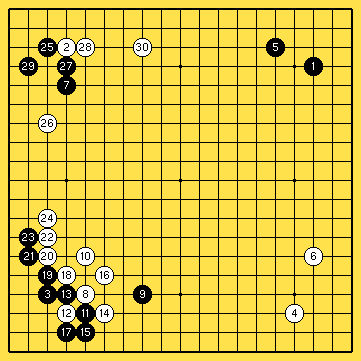 |
Later on in this game a big fight developed and black
managed with a truly exquisite move to barely ensure
life and thus killing the white stones which had only
one of those things, eyes. White resigned after move 145.
The joseki in the upper left corner is not all that
special but the sequence of moves in the lower left is
one I never saw before (and never hope to see again).
White clearly made a judgment call here and decided to
give black a lot of points in exchange for some stones
towards the center. It seems that black is doing fine
here, I wouldn't complain if this were my game.
|
Diagram 17 |
|
|
|
Surprise Your Club |
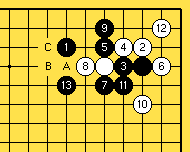 |
To give you an edge at your local go club it is a
good idea to have a closer look at dia 18. As anybody
can tell you, normally black is supposed to play at 4
instead of black 3. The blunt move of 3, however, is
possible too and an unexpectedly large number of players
seem to never have heard of it. The result in the dia
looks natural and very joseki like but it does favor
black and white should not be satisfied with it. Black
13 neatly captures two white stones and he's happy.
White should not play as docile as in the dia but should
play 10 at A instead. After this all hell breaks loose
as black has the fierce diagonal move (hane) at B. If
black does not feel up to the difficult fighting which
follows he also can stretch at C, now the result is
unclear but something tells me it cannot be bad for
white.
|
Diagram 18 |
|
|
|
Surprise Your Club II |
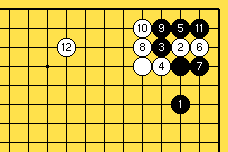 |
Dia 19. I remember as if it were yesterday that this
joseki was the latest hit at the go club I was playing
when I was about 6 kyu. We all thought that white was
taken in big time and that black had played a cool trick
joseki. Well, actually the result in dia 19 is about
even and there nothing "hamete" (tricky move) about
it. So, don't be surprised when your opponent does not
answer as you had anticipated but instead plays hane at
3 and easily captures two stones of yours.
|
Diagram 19 |
|
|
|
Answer To Dia 9 |
 |
Black: Cheng Zengyu
White: Wang Yuan (+resign)
Played April 1986
(continuation)
Black 15 was the biggest point at the board and also
helps to set up the counter pincer at 25. Notice that
before starting the heavy fighting black plays 29 in
order to make one and a half eye, this is always a good
idea, of course.
|
Diagram 20 |
|
|
|
Be sure to come back next month for the next episode of "Gentle Joseki"
Appendix 01
Index of joseki's mentioned in this episode:
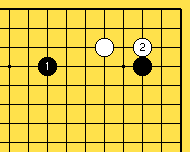
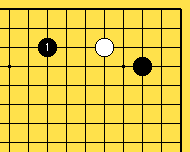

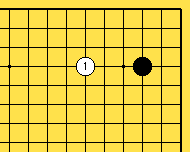
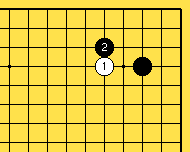
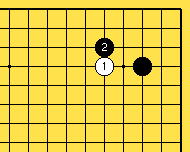
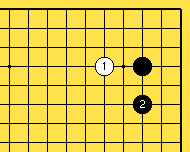
Appendix 02
Some Japanese words and their English equivalents:
| TERMS |
|---|
| aji |
taste; remaining possibilities, however distant they may be |
| atari |
"check" on at least 1 stone |
| dan |
ranking system for stronger players |
| fuseki |
opening |
| gote |
not being able to leave the current situation first,
allowing your opponent to be able the play elsewhere first |
| hoshi |
star; any of the 9 dots one the go board,
the middle one is called "Tengen" (=center/origin of heaven).
Hoshi is often used when talking about an opening move
on the 4-4 point. |
| joseki |
a sequence of moves (in the corner) giving both players
a locally equal results |
| kakari |
approach move to the corner |
| kikashi |
a move which is almost impossible to ignore,
also "forcing move" |
| ko |
situation which occurs when it is possible to immediately re-capture
the stone your opponent played in the previous move to
capture 1 of your stones.
Since there is no end to this there is the ko-rule,
which prohibits a player to exactly recreate a previous
board position. |
| komi |
compensation for white (usually 5-7 points) since black
gets to play the first move. (often there is a half point komi,
as in 5.5 stones komi, to prevent a game from ending
in a draw) |
| komoku |
the 4-3 point |
| kori-gatachi |
inefficient shape, uneconomical, using to many stones
to make only few points (hollow wall) |
| kyu |
rating system used for intermediate players |
| miai |
of equal value |
| moyo |
large framework often forcing the opponent to (try to)
reduce it drastically in order to stay in the game |
| ni-ren-sei |
two 4-4 moves one the same side of the board |
| ponnuki |
the name of the shape when 4 stones capture one enemy stone |
| san-ren-sei |
3 hoshi of the same color at the same side of the board |
| sente |
having the opportunity to play elsewhere first
leaving the current situation.
(example: He had sente so he decided to play tenuki) |
| shimari |
"closing" (the corner) formation, any 2 moves which effectively
seal the corner, also "enclosure". |
| shin-fuseki |
"New Opening" a way of playing starting in the 1930's which
does not accept the go-theory of the 19 century as being
without its weak points. |
| tatami |
thick mats of woven rush stuffed with straw,
traditional flooring |
| tenuki |
playing else first when judging the current situation
does not require an immediate follow up |
| warui |
bad |
Copyright by
Pieter Mioch, June 2001
